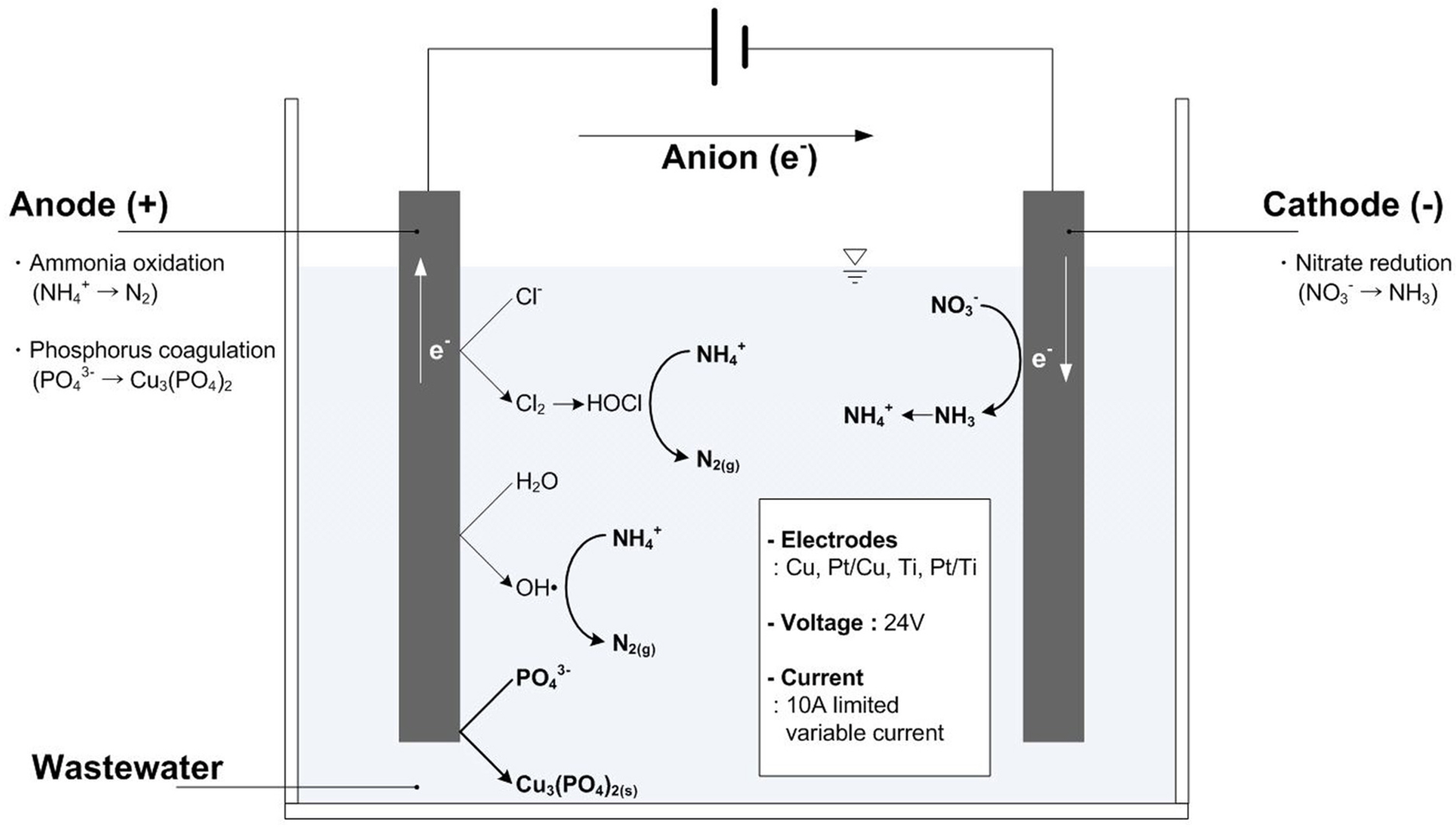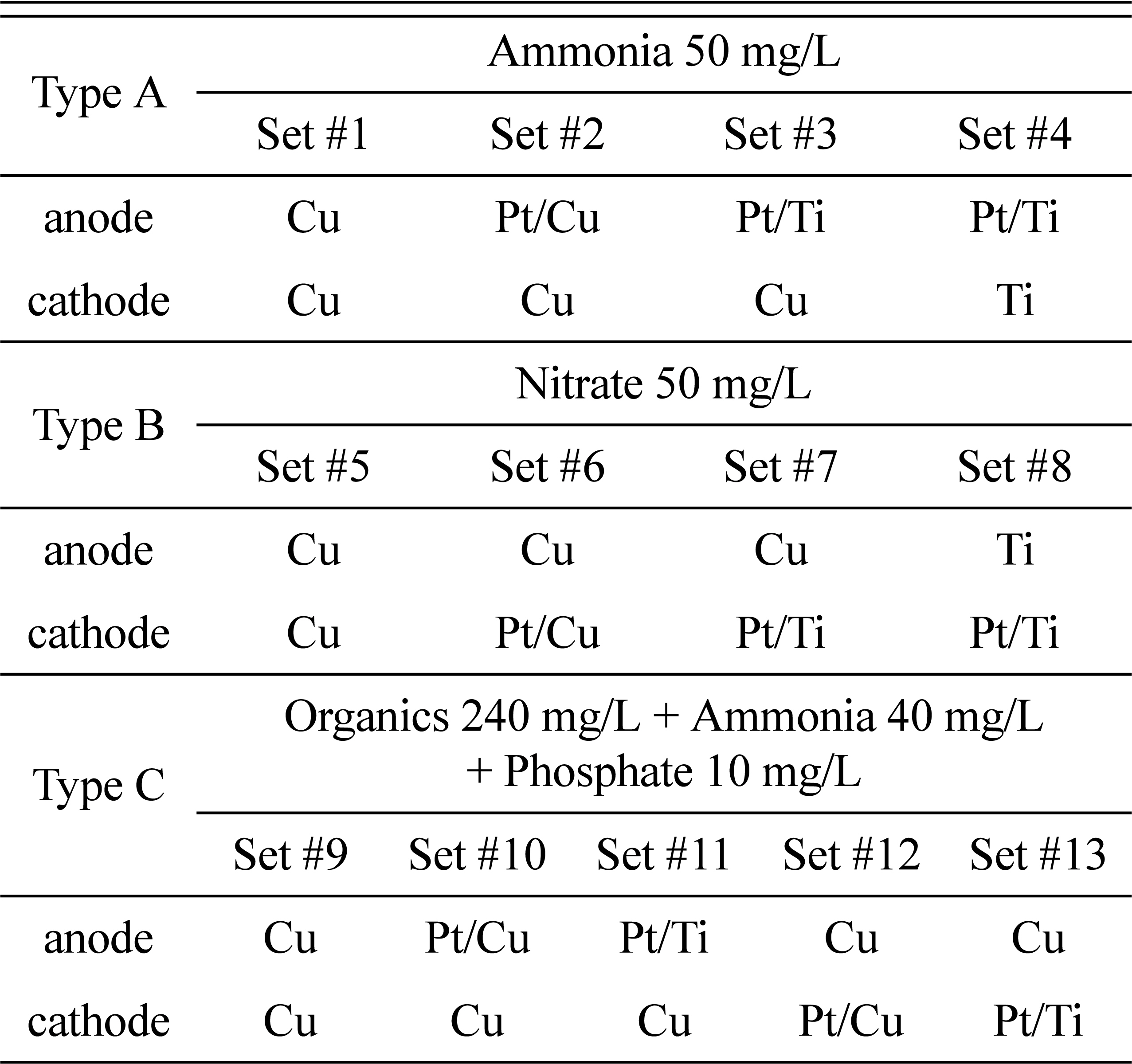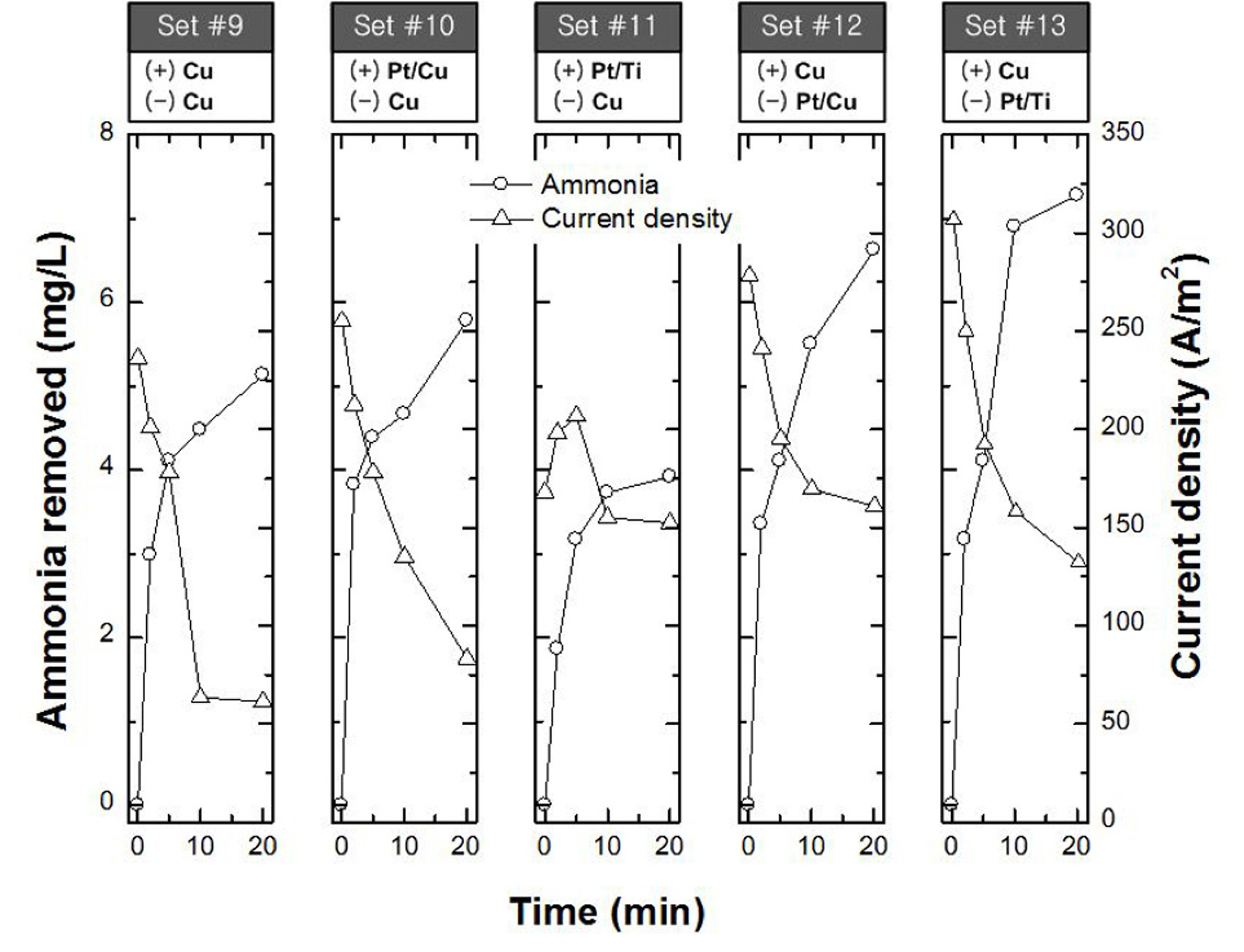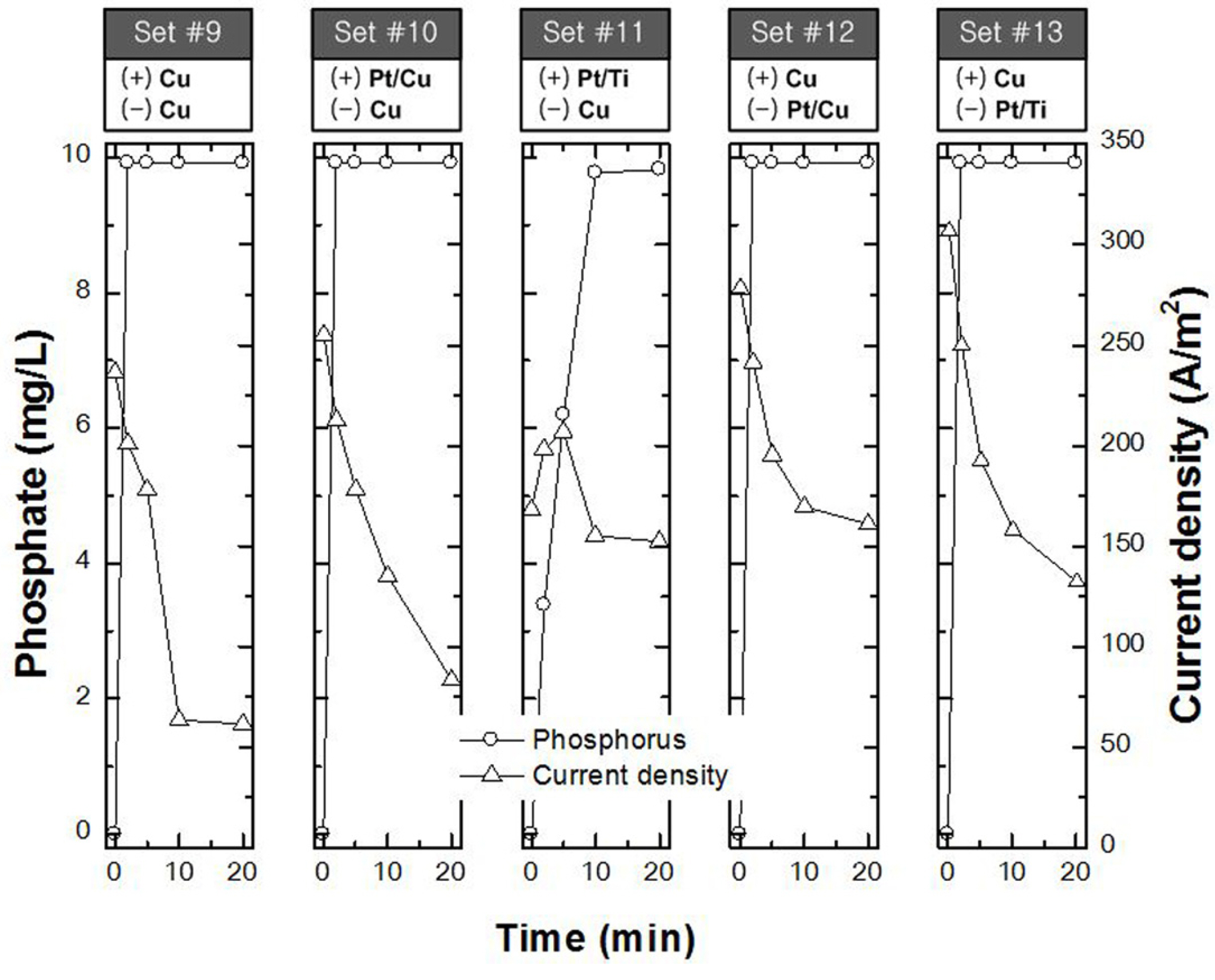Performance Assessment of Electrolysis Using Copper and Catalyzed Electrodes for Enhanced Nutrient Removal from Wastewater
Article information
Abstract
The performance of electrolytic processes using copper and catalyzed electrodes for enhanced nutrient removal with various catalyzers and combinations of electrodes was evaluated. The catalyzed electrodes removed more ammonia nitrogen than the copper electrode, but higher ammonia removal was achieved using a Pt/Ti anode. On the other hand, electrolysis using the Pt/Cu anode consumed less energy and cost less. During electroreduction, nitrate was better removed by a pair of copper electrodes than by the catalyzed electrodes. During electrolysis of synthetic wastewater, ammonia removal not only increased owing to direct oxidation at the anode, but was also influenced by indirect oxidation at the cathode. Platinum-coated copper and titanium cathodes actively produced oxidizers and thus removed more ammonia than a pure metal cathode. Although phosphorus was removable irrespective of the type of catalyzer, electrocoagulation using the copper electrode achieved complete removal of phosphorus in a period of less than 10 min.
1. Introduction
Nitrogen and phosphorus are widely known as essential nutrients for plant growth. Enrichment of these nutrients in aquatic environments can promote excessive growth of algae, however, and lead to a water pollution problem called eutrophication [1]. This may occur by the addition of natural nutrients to water or as a result of human activities such as the use of fertilizers and discharge of wastewater [2]. Eutrophication can cause negative environmental effects such as proliferation of harmful algal blooms, deterioration of water quality, depletion of oxygen in water, and subsequent threats to human health [3]. Electrolysis technology has been investigated for nutrient removal in recent years, and it has been applied extensively to treat various types of wastewater [4-8]. The use of electrolysis provides many advantages such as (1) a much smaller required area owing to the shorter reaction time, (2) continuous treatment of wastewater originating from small-scale communities, (3) simultaneous removal of organics and nutrients without additional complicated facilities for chemical dosing and air supply, and (4) insensitivity to environmental factors.
Contaminants in wastewater can be eliminated by electrochemical reactions such as electrooxidation, electroreduction, or electrocoagulation during the electrolysis procedure. Ammonia is generally removed by both a direct oxidation reaction at the electrode surface and indirect oxidation that occurs through the oxidants produced by electrolysis [9-11]. Soluble organics can also be decomposed by electrooxidation, whereas nitrate, which is the oxidized form of nitrogen, can be removed by electroreduction [12,13]. Substances such as insoluble organics, suspended solids, and phosphate can also be eliminated by the electrocoagulation reaction [14-16].
For wastewater treatment, many types of metal such as aluminum, iron, Ti/IrO2, and Pt/Ti are commonly employed as the electrode in electrolysis [17,18]. Aluminum and iron are the materials most widely used as electrodes because their use guarantees relatively good electrocoagulation performance. However, aluminum and iron electrodes can be easily ionized at the anode, and it is hard to obtain considerable removal of soluble organics and ammonia because of the lower oxidizing power during the electrooxidation reaction. The use of a dimensionally stable anode with high activity, for example, a titanium electrode, is also very efficient for removing organics and ammonia owing to its higher oxidizing power, though it also has limitations such as nonreactive electrocoagulation and high cost.
Copper, with its positive redox potentials, has advantages such as greater oxidizing power [19], a slower exhaustion rate, and easier maintenance than other metals used as electrodes. To exploit these advantages and overcome the disadvantages of existing electrode materials, therefore, copper (which, like gold, is known as a noble metal) was adopted in our previous studies [20-24]. Electrolysis using copper electrodes was also applied for the treatment of various types of wastewater discharged from agro-industrial complexes, laundry plants, and sewers in small-scale communities. Remarkable removal rates of total phosphorus, as high as 99%, could be achieved in sewage treatment by electrolysis using a copper electrode, whereas the removal of total nitrogen, which consists of organic nitrogen, ammonia, and nitrate, was about 60% [20]. Most organic nitrogen could be eliminated by electrocoagulation, whereas ammonia and nitrate were eliminated by electrooxidation and electroreduction, respectively.
Higher activity at the anode and strong reduction potential at the cathode are essential for electrooxidation and electroreduction, respectively, during the electrolysis procedure. Similarly, the anodic activity depends on the value of the potential difference (voltage), i.e., the overpotential, that occurs during generation of molecular oxygen through a chemical reaction (oxygen evolution) [18]. Numerous studies on the use of various types of anodes such as graphite, platinum, lead dioxide (PbO2), iridium oxide (IrO2), titanium dioxide (TiO2), and tin dioxide (SnO2) for electrolysis have been conducted [18,25-27], and active electrooxidation reactions have been observed as a result of the characteristics of these anodes, which have overpotential values of 1.3-2.8 V resulting from oxygen evolution.
The use of a catalyst-plated electrode would be an alternative method for promoting the electrooxidation reaction during electrolysis, and Marincic and Leitz [28] also reported that more than 90% of ammonia could be removed by electrolysis using a titanium electrode coated with a platinum catalyst. Even though it has economic disadvantages, platinum is the most active metal that can improve the electrooxidation reaction kinetics of ammonia [29]. In recent years, coupled electrodes of copper and various metals, including coated alloys, have also been studied for advanced removal of nitrate by electroreduction [30-33].
In this study, various combinations of copper and titanium electrodes, bare or coated with platinum, were applied as the anode and cathode to enhance both the electrooxidation and electroreduction reactions, and the effects of the catalyst and electrode materials on the removal of nutrients from wastewater were also evaluated.
2. Experimental Section
2.1 Electrolysis system and electrodes
The electrolysis system consisted of a 250 mL batch-type reactor and a pair of electrodes connected to a power supply, as shown in Fig. 1. As mentioned earlier, ammonia oxidation and nitrate reduction can be performed at the anode and cathode, respectively, during the electrolysis procedure. Therefore, various electrodes made of copper, titanium, and catalyst-coated metals, specifically, copper coated with platinum (Pt/Cu) and titanium coated with platinum (Pt/Ti), were used for nitrogen removal.
Pt/Cu and Pt/Ti electrodes were prepared by the polyol method as follows. Ti and Cu electrodes were submerged in boiling NaOH aqueous solution (1 M) for 10 min and immediately immersed in boiling water for 30 min. Then, they were dried in an oven to roughen their surfaces. As a result, Pt nanoparticles were formed on the surfaces of the Ti and Cu electrodes. Fig. 2 shows scanning electron microscope (SEM; COXEM, EM-30) micrographs of the surface morphology of the electrodes before and after Pt coating. Pt nanoparticles covered the surface of the electrodes, and the thickness of the coating was equal to the size of the Pt nanoparticles. The crystallinity of Pt metal on the Pt-coated electrodes was also analyzed by X-ray diffraction (Rigaku, D/max-2500/PC). Combinations of electrodes were applied considering the wastewater characteristics, as presented in Table 1. The width and length of each electrode were 7.5 and 170 mm, respectively, and most of each electrode was submerged in the wastewater. The spacing between the anode and cathode was also 7.5 mm, and the distance was maintained by using a plastic clamp.
Existing electrolysis processes have generally been operated under variable voltage and constant current conditions, but problems such as greater accidental electrocution risk and electric power consumption have been encountered, and the contaminant concentration in wastewater has not been considered. Thus, in this study, electrolysis was conducted under a fixed voltage of 24 V and a variable current with an upper limit of 10 A, which were the optimal operating conditions derived from our previous result [34].
2.2 Wastewaters
Three types of synthetic wastewater were prepared, as shown in Table 1, and 250 mL of wastewater was used for each electrolysis experiment. The wastewaters designated Types A and B consisted of solutions of ammonium chloride (NH4Cl) and potassium nitrate (KNO3) in distilled water for added ammonia and nitrate, respectively. The synthetic wastewater designated Type C had a chemical oxygen demand (COD) concentration of 240 mg/L, 40 mg/L of ammonia, and 10 mg/L of phosphate, which is similar to the composition of typical wastewater in Korea.
2.3 Analysis method
The ammonia content, nitrate content, pH, oxidation-reduction potential, conductivity, and total suspended solids were measured according to the procedures in the American Public Health Association Standard Methods [35]. The current values between the anode and cathode were simultaneously measured using a multitest meter (Fluke, Fluke 175).
3. Results and Discussion
3.1 Effect of electrode materials on ammonia removal
The representative removal mechanisms of ammonia during the electrolysis procedure can generally be explained by the following reactions:


Ammonia is electrooxidized by an electrochemical reaction at the anode, as shown in Eqs. (1) and (2) [36]. As mentioned above, higher activity at the anode is also essential for electrooxidation during the electrolysis procedure. Thus, various anodes made of copper, titanium, and catalyst-coated metals, specifically, copper coated with platinum (Pt/Cu) and titanium coated with platinum (Pt/Ti), were applied to derive the optimal combination of electrodes for ammonia oxidation, as presented in Table 1.
Fig. 3 shows the effect of the electrode materials on electrooxidation of ammonia and the variation of the current density for wastewater of Type A, which contained only ammonia nitrogen. The results of electrolysis experiments using various types of electrodes show that ammonia removal was strongly influenced by the characteristics of the anode material. Ammonia oxidation was more than 7% greater when the Pt/Cu anode was used during the electrolysis procedure than when the uncoated copper anode was used. However, the mass of removed ammonia was more than 53% greater for the Pt/Ti anode than for the Pt/Cu anode. This result reveals that the anodic activity can be enhanced by coating catalyzers on the electrode, and that the titanium electrode is more effective than the copper electrode for ammonia removal.
The Pt/Ti anode has a broad specific surface area owing to its mud-cracked morphology, and direct ammonia oxidation on its surface can be more active than on the copper-only anode [37]. When electrolysis using the copper-only or Pt/Cu anode was performed, as illustrated in Fig. 3, a noticeable decrement of the current density was observed, unlike the case for the Pt/Ti anode.

where NH4+ = concentration of ammonia (mg/L)
F = Faraday constant (96,487 C/mol)
V = volume (L)
I = current (A)
t = electrolysis time (h)
Eq. (3) is of the form proposed by Chen et al. [36] for the instantaneous current efficiency (ICE) of electrooxidation of ammonia. They reported that the ICE is proportional to the mass of oxidized ammonia and that it was in the range of 0.01 to 0.07. The ICEs at the Pt/Ti and copper anodes were 0.06 and 0.04, respectively. This result shows that better electrolysis and ammonia removal can be expected by using the Pt/Ti anode, with its high current efficiency, than by using the copper anode.
The term “charge loading” generally refers to the electric charge per volume during the electrolysis procedure, and ammonia removal can be affected by the charge loading. The amount of removed ammonia increased with increasing charge loading, as presented in Fig. 4. Increments in charge loading can be obtained by increasing the current or extending the reaction time for electrolysis. Ohm’s law also states that the current through an electrode between two points is directly proportional to the voltage across the two points. Under a constant voltage, therefore, the current can be affected by the activity of the electrode or the electric resistance caused by the influent wastewater. As shown in Fig. 4, the highest charge loading was observed for the combination of a titanium anode with a copper cathode. At constant charge loading, greater ammonia removal could also be achieved by using the platinum-coated anode rather than the copper anode owing to the high oxidation activity of the platinum catalyst. Therefore, it is believed that the electrical energy available for ammonia oxidation and anodic activity can be improved by using the coated anode.
Energy is generally consumed during the electrolysis procedure to remove pollutants in wastewater. The energy consumption (EC) for electrochemical oxidation of ammonia can be calculated as [38]

where U = voltage (V)
The EC values of the Pt/Ti and Pt/Cu anodes were 27.80 and 21.44 kWh/m3, respectively. The EC values calculated by Eq. (4) and the ICE calculated by Eq. (3) were inversely proportional to each other, and less energy was consumed in the electrolysis experiment using the copper anode. From the above results, it is believed that significant ammonia removal can be achieved by using a Pt/Ti anode with high activity and charge loading. However, the use of a Pt/Cu anode can be more attractive economically, because the application of a Pt/Ti anode for electrolysis not only requires higher energy consumption, but also costs about ten times as much.
3.2 Effect of electrode materials on nitrate removal
The representative mechanism of nitrate removal during the electrolysis procedure can generally be expressed by the following reaction:

Eq. (5) shows that nitrate can be removed through the mechanism of electroreduction at the cathode [39]. Various cathodes made of copper, titanium, and catalyst-coated metals, specifically, copper coated with platinum (Pt/Cu) and titanium coated with platinum (Pt/Ti), were applied to determine the optimal combination of electrodes for increasing the reaction activity and maximizing nitrate reduction. Fig. 5 shows the effect of the electrode materials on electroreduction of nitrate and the variation of the current density for Type B wastewater, which contained only nitrate.
The most nitrate was removed when copper was used simultaneously as both the cathode and anode. The amount of nitrate removed at the Pt-coated cathode was smaller than that at the copper-only cathode (Sets #6 and #7 in Fig. 5). In other words, the platinum coating used to improve the electroreduction performance interfered with the reaction rather than catalyzing it. Çirmi et al. and Nguyen et al. also reported that nitrate removal was diminished when a copper electrode was coated with polypyrrole [33, 39]. Nitrate, which is the oxidized form of nitrogen compounds, can generally be electroreduced by gaining electrons in a reaction. In this study, however, it seemed that the catalyst-coated cathodes, rather than the copper-only option, yielded insufficient reduction of nitrate. The study conducted by Çirmi et al. [33] showed similar results through an analysis of the potential difference between the copper and catalyzed electrodes. Reyter et al. [30] also reported that active reduction of nitrate could be obtained by using a copper-only cathode.
A Ti anode and a Pt/Ti cathode (Set #8 in Fig. 5) were also applied to evaluate the effect of the anode. In contrast to the result for the copper anode, only minimal nitrate reduction occurred when the titanium anode was used. However, another study performed by Li et al. [31] demonstrated that 80% nitrate removal could be achieved by using a platinum-coated titanium anode. Thus, the presence or absence of a catalyst coating on the anode can strongly affect electroreduction. When the copper electrode was used, however, nitrate reduction could be successfully achieved regardless of the catalyst coating.
Fig. 6 shows the effect of charge loading on nitrate reduction. A linear relationship between the charge loading and the amount of removed nitrate was observed, and this was similar to the case of ammonia oxidation, as presented in Fig. 4. Regardless of the presence or absence of the catalyst coating on the anode, higher charge loading was observed when the copper electrode was used. Further, the charge loading when the titanium electrode was used was lower than that for the copper electrode. Under the same operating conditions, relatively poor charge loading was observed in electrolysis using titanium as the anode and cathode, and nitrate removal was not obtained. Nitrate can generally be removed through reduction to ammonia during the electrolysis procedure, as described in Eq. (5), and the ammonia is oxidized to nitrogen gas, as presented in Eqs. (1) and (2).
Fig. 7 shows the effect of the electrode materials on the nitrogen compound content for Type B wastewater, which contained only nitrate. When the titanium electrode was used as the anode (Set #8 in Fig. 7), no changes in the total nitrogen were observed because nitrate was not reduced. When the copper electrode was applied as the anode, on the other hand, the concentration of total nitrogen decreased because of oxidation of the ammonia produced by nitrate reduction. Most of the total nitrogen could also be removed when copper electrodes were used as both the anode and cathode (Set #5 in Fig. 7), giving the highest nitrate reduction performance. Thus, the total nitrogen removal performance was influenced by the effectiveness of nitrate reduction during the electrolysis procedure, as described in Eq. (5).
3.3 Effect of electrode materials on removal of nitrogen and phosphorus in synthetic wastewater
The effect of the electrode materials on the removal of ammonia in wastewater containing various pollutants during the electrolysis procedure was also evaluated, as shown in Fig. 8. The optimal electrode materials and combinations of materials derived from the above results were applied (Sets #9-#13 in Table 1), and Type C synthetic wastewater with a COD of 240 mg/L, 40 mg/L of ammonia, and 10 mg/L of phosphate, which is similar to the composition of typical wastewater in Korea, was prepared and used.
When a Pt/Cu electrode was applied as the anode, as shown in Fig. 8, higher ammonia removal could be achieved by using the copper electrode as the cathode in electrolytic treatment of wastewater containing various pollutants. Note that this result agreed with that of Type A wastewater, which contained only ammonia. When a Pt/Ti electrode was applied as the anode for electrolytic treatment of the synthetic wastewater, however, the lowest ammonia removal was observed, in contrast to the result for Type A wastewater. The ICE values for removal of ammonia in the synthetic wastewater ranged between 0.03 and 0.02 overall under the conditions presented in Fig. 8, and these values were lower than those for Type A wastewater. It is believed that the electrical energy for ammonia oxidation was decreased because Type C wastewater contained phosphate, which could be coagulated by the electrolytic procedure.
Electrooxidation of ammonia can be affected by the anode material as well as the cathode material. Higher ammonia removal could be obtained by using a platinum-coated cathode when a copper anode was used (Sets #12 and #13 in Fig. 8). During the electrooxidation reaction, direct oxidation generally occurs at the anode, and the indirect oxidizing agent, hydrogen peroxide, can also be produced at the cathode [40,41]. Thus, in this study, it could be confirmed that not only direct oxidation at the anode but also production of the indirect oxidizing agent at the cathode played important roles in ammonia removal during electrolysis of wastewater. In addition, the Pt/Cu and Pt/Ti cathodes, at which the highest ammonia removal could be achieved, consumed 28.9 and 30 kWh/m3 of energy, respectively. Although the difference in energy consumption between the Pt/Cu and Pt/Ti cathodes was not large, Pt/Cu was more economically advantageous.
Phosphorus can also be removed through the mechanism of electrocoagulation at the cathode, as expressed in Eqs. (6) and (7) [34], whereas organics such as the biological oxygen demand (BOD) or COD can be treated by electrooxidation.


Fig. 9 shows the effect of the electrode materials on electrocoagulation of phosphate. In a preliminary treatability test, electrocoagulation of phosphate did not occur at the electrode made of pure titanium coated with platinum. Therefore, a Ti-6Al-4V alloy, made of 6% aluminum and 4% vanadium, was used in this study as the titanium electrode for electrocoagulation of phosphate. As shown in Fig. 9, higher phosphorus removal could be achieved by all the combinations of electrodes used in this study. When the Pt/Ti anode was used, however, slow electrocoagulation for phosphorus removal was observed at the beginning of the reaction for about 10 min. However, the phosphorus could be completely removed in a relatively short reaction time by using the copper anode.
4. Conclusion
Various electrodes made of copper, titanium, and catalyst-coated metals, specifically, copper coated with platinum (Pt/Cu) and titanium coated with platinum (Pt/Ti), were applied as the anode and cathode to enhance both the electrooxidation and electroreduction reactions. The effects of the catalyst and electrode materials on the removal of nutrients from wastewater were also evaluated. During electrolysis using a platinum-coated copper anode, up to 7% more ammonia removal was achieved relative to the performance of an uncoated copper anode. The Pt/Ti anode removed 54% more ammonia than the copper anode. Therefore, the catalyzed electrodes are able to remove more ammonia nitrogen than the copper electrode, but using the Pt/Ti anode should result in even higher ammonia removal. During electroreduction, nitrate was better removed by a pair of copper electrodes than by the catalyzed electrodes. In experiments with synthetic wastewater, ammonia removal using the Pt/Cu anode was 13% greater than that using just the copper anode, similar to the result for treatment of pure ammonia solution. The copper electrode coated with a platinum catalyzer was more effective overall than just the copper electrode regardless of the influent characteristics with respect to electrolysis for ammonia removal. Although phosphorus was removable irrespective of the type of catalyzer, electrocoagulation using the copper electrode achieved complete removal of phosphorus in a period of less than 10 min.
Acknowledgements
This research was supported by Materials and Membranes (M&Ms) Co., Ltd. of Korea.









